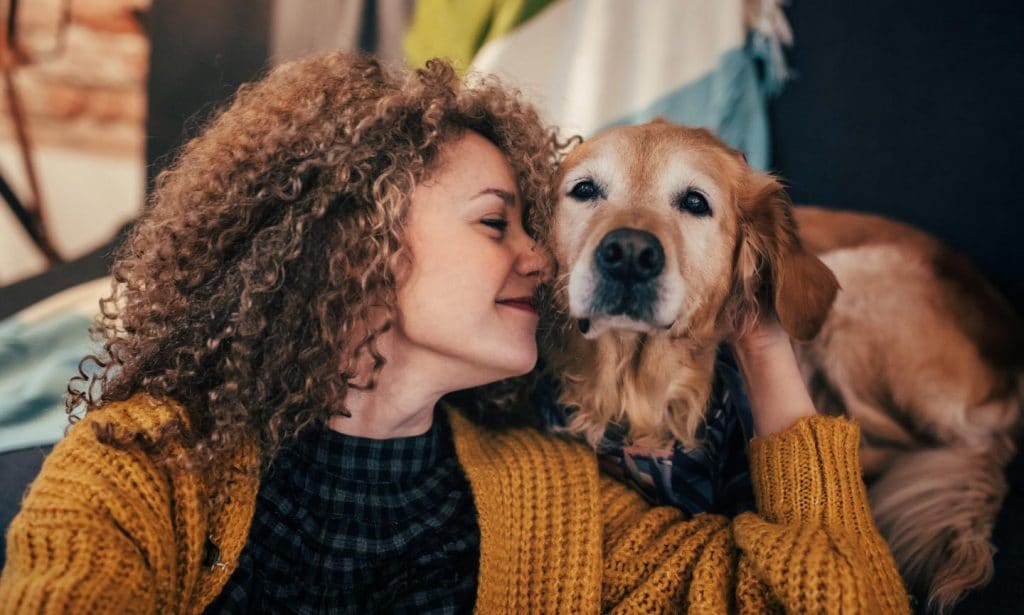At the start of 2020, Jillian Sandler of Newburgh, New York, was a busy medical student attending a physician assistant program. But when the pandemic struck, the program paused its hospital rotations, and Sandler found herself with a lot more free time. She’d been volunteering at Dutchess County SPCA in Hyde Park, New York, so when the shelter asked for fosters, it got her thinking about how to foster a dog.
"I'd always wanted a dog. I just never really had the opportunity to have one,” Sandler says. That’s why she looked into how to become a foster dog parent, and eventually started fostering. "Even giving the dog a day or a week of experience outside the shelter is good for them, just to see what real life is like," she says.
Sandler contacted the shelter, filled out an application and got matched with a 10-year-old dog. And she wasn’t alone—the number of people who decided to foster dogs went through the roof when much of the country went into lockdown and dog lovers were stuck at home. But you don’t need a pandemic to give a dog a temporary home, and the rewards are many—for pooches and people alike, say pros. So how do you foster a dog? Here’s a step-by-step guide to everything you need to know.

1 Learn the Basics
Before you dive headfirst into fostering dogs, you’ll want to know exactly what you’re signing up for. So, what exactly is dog fostering?
“Fostering means providing a temporary home for an animal until a forever home can be found,” says Audrey Lodato, director of animal care at Dutchess County SPCA. There are lots of reasons why an organization puts out the call for fosters, she says. Sometimes it’s because the shelter is just too full. Other times it’s because a particular dog needs a place to recuperate from surgery, is undergoing heartworm treatment, is about to give birth, or is a puppy or senior dog who will thrive better in a home environment.
So what does it take to become a foster dog parent? Anyone who can keep a dog safe in their home, who’s responsible with pets, and who has love to give can learn to be a foster, Lodato says. Prospective foster parents should have enough time to be able care for the dog—but the needs will vary according to the animal. It doesn’t matter if you’ve never cared for a dog, either. In fact, Lodato says, “a lot of people get into fostering to try out owning a pet.”
Just be sure you know what you’re taking on, Lodato advises. “Some organizations have a lot of animals coming in and out, and so there are a lot of highly adoptable, really easy animals that just need a place to crash for a couple of weeks. And then some organizations are very specialty, like a breed-specific rescue that only works with dogs that have behavior issues.” Knowing why the dog needs to be fostered will give you a better chance of finding the right fit, she says.
2 Find a Foster Program at a Shelter or Rescue
If you’re eager to foster a dog, we’ve got good news: Getting started is easy. Most rescues and shelters have foster programs and the first step is simply reaching out to the organization. That’s how Lauren Alpert of Brooklyn, New York, got started: She began following rescue groups on Instagram, and applied to foster with them. (In general, rescue groups are primarily foster-based—their dogs are fostered until they’re adopted.) Eventually, Alpert settled with a New York City organization called In Our Hands Rescue, after going to several of their adoption events and talking to the foster coordinator. Alpert loved the experience so much that she adopted her first foster dog and has fostered 13 more pups in the year since.
If you have a choice, how do you decide between fostering from a rescue or a shelter? “For the first-timer,” says Debbie Johnson of Asheville, North Carolina, who’s fostered dogs for 20 years through Mountain Pet Rescue and her local shelter, the Asheville Humane Society, “it might be beneficial to foster for a shelter-based group, because that way, if you do end up getting an animal that ends up not ultimately meshing well or that is beyond your capacity to handle, you have an escape valve where that dog has a shelter environment that it can go back to.”
3 Submit an Application
No matter which organization you go with, in order to foster a dog, you’ll need to fill out an application and give references. The application will usually ask you whether you rent or own your home, how many people are in your family, and to describe any past experiences with pets, Lodato says.
It’s important to be completely honest when you’re applying, Johnson says, because shelter or rescue staff will use the information you provide to choose a dog who meets your needs. If you exaggerate how much experience you have with dogs, for instance, you may end up with a foster pup who needs more training or supervision than you’re able to provide—a bad experience both for you and the dog you’ve been entrusted to care for. So go ahead, tell the truth. The worst that can happen is that you’ll be turned down—and if that’s the case, well, there’s always volunteering!

4 Talk to a Foster Coordinator
After you put in your paperwork, a foster coordinator typically follows up with a phone call to make sure you understand the organization’s expectations and rules for foster parents. Some groups may also ask for a virtual or in-person tour of your home.
Again, it’s important to be transparent about the details of your daily life during this interview. “Definitely have an idea of what you can and can’t handle, and be honest about whether you’re at work all day, whether you are a really active person who’s going to take this dog running, or whether you have a fenced-in yard,” Johnson recommends. “When I first started, I didn’t really understand how it worked, and I was given a dog who was not a good fit for me. And as I’ve gone on, I have definitely learned to be more assertive. I know that I need a dog who will get along with my dog, and one who is OK with being left alone for a while.”
Your interview with a foster coordinator is also a two-way street, Lodato says—it’s a great opportunity to ask questions about the organization and what’s expected of you. Read any agreement you get from the organization carefully, she adds, and make sure you understand what to do if there’s an emergency or if you decide to adopt the pet.
Most organizations have rules, like making sure the dog will be living inside your home rather than outside and, for some pets, refraining from taking your foster to the dog park to avoid scaring or overwhelming them. If you already have a pet at home, you may be asked to keep the two animals separate for a week or two (so it’s good to have a spare room to place your foster.) Ask your coordinator for a list of rules to follow in advance, so you can consider whether you’re able to follow them before you bring a foster dog home.
Another important question: What pet products, if any, will you be responsible for buying? Foster organization will usually pay for the supplies you’ll need to take care of your temporary pup, Lodato says, as well as the costs of vet visits or other medical treatment. “It’s great when fosters can assist with paying for food, but we understand that’s not always the case.” If the rescue or shelter is a nonprofit organization, whatever you buy, even dog toys, may be considered a donation and therefore tax-deductible, making it a win-win for you and your foster pooch. To avoid any budget-breaking concerns, talk to your foster coordinator to clarify exactly what supplies they will provide and which, if any, you’ll be paying for out of your own pocket.
You should also ask the organization for its procedures for offering support and answering questions, Alpert says. In cases of illness or accident, for example, you’ll want to know whether there’s a phone number to call for help. “You want to work with a rescue that will offer the right support for you in case anything goes wrong,” she says. “You want to be able to get in touch with someone right away.”
Other questions to ask, according to Lodato, include:
- How long does the organization expect you to keep the pet?
- Who’s responsible for providing the pet’s food and supplies?
- When and how often does the pet need to come back for vet appointments?
5 Complete Any Required Foster Dog Parent Training
Once you’re accepted as a prospective foster dog parent, your shelter or rescue may invite you to an orientation and/or training session (online or in person), where you learn the essentials of fostering and dog-handling basics, like using a harness and crate training. These classes can be especially useful for first-time dog parents, but they also serve as a great refresher for any foster dog parent who’s been out of the pup parenting game for awhile.
These trainings are common but not universal; other organizations skip formal orientations and expect all questions to be handled during the initial conversation with the foster coordinator, and other groups offer a manual where all instructions are spelled out. Follow your foster coordinator’s lead when it comes to training, and don’t be afraid to ask for extra help if you think you could use it.
6Bring Your Foster Dog Home
At last, you’re fully prepared to become a foster dog parent! As dogs become available, you’ll be called by the organization to see if you can take a particular pup in. Say yes, and you’ll be asked to schedule a time to pick them up. “If the animal has specific behavior or medical concerns, we might first arrange a longer meeting with the foster,” Lodato says.
Once you’ve brought your foster dog home, you’ll typically be expected to:
- Take the dog to the vet when necessary
- Bring the dog back to the shelter to meet prospective adopters, or attend your rescue’s adoption events, either in person or virtually, with the dog
- Send updates and photos so the organization can learn more about the dog and use the info to write a compelling adoption profile for them
- Provide basic care, like walking and feeding. Sometimes foster parents are asked to train the dog to make them more adoptable, focusing on potty training or teaching simple commands
- Give medication (if the dog needs it)
For some pups, like dogs working on behavioral issues, shelters and rescues will make specific recommendations. “Everything is really circumstantial to the animal, so these recommendations can be anything that the animal is going to need to make their adoption experience better,” Lodato explains. “We had a dog that was terrified of cars. So we actually had her foster parent feed her all her meals in the backseat of her car. Or, if the dog eats really fast and then throws up because they haven’t had access to food regularly, we might give the foster a puzzle feeder so the dog learns to slow down to eat.”

7Get Support
Foster dog parenting is a big responsibility, but you don’t have to do it alone, especially if you’re learning how to foster a dog for the first time. After you’ve brought your foster dog home, it’s common for shelters and rescues to pair you with a staff contact person or a more experienced foster parent as a buddy, to answer your questions along the way. You may also be able to join a community of foster parents in your area.
“Most of the groups I’ve fostered for typically have a private Facebook group where fosters can get help, advice and insight from a variety of folks in the rescue world,” Johnson says. In other words, you won’t be flying solo. “Having the support from the rescue has been the biggest piece, knowing that I’m not just doing this on my own,” Alpert says.
8Find Your Dog a Forever Home
The length of time the foster dog spends with you will vary, too. Ideally, you’d keep the foster until they’re adopted, which may be as short as a weekend or as long as month or more.
While you foster, you can help your shelter or rescue find a permanent home for the dog in a number of ways, Lodato says. Keep them updated on their behaviors, their likes and dislikes, and if possible, their reactions to other dogs and children—anything that will help answer common questions prospective parents might have. Take plenty of photos and videos for the organization to share on social media. And of course, be ready to attend adoption events or meetups with interested adopters.
If you’re a dog person—and if you’re considering fostering dogs, you definitely are—there’s a good chance you’re going to bond with your foster pup. For some foster parents, the attachment is so strong that it results in a “foster fail,” a negative-sounding term for the positive experience of permanently adopting a dog you’ve been fostering. Just ask Sandler, who fell hard and fast for her foster pup and ultimately adopted her. “After having her home for a week or two, I knew that there was no way I was giving her away,” Sandler says.
But not all foster dog parents can make that long-term commitment. For Johnson, the solution is simple: “I don’t fall in love with the animal to the point that I have to have them. I fall in love with the idea of that animal finding the perfect home,” she explains.
In the end, that’s what fostering is about—it’s a partnership between you and your shelter or rescue organization with the same goal: to get the dog into their forever home (even if it turns out to be yours). For some rescue pups, that’s easy. For others who need more training and care, it’s more challenging—which can make success even sweeter.
“It’s fun to watch these dogs come out of their shell, to be the person who’s showing them some consistency, some routine, watching them play with toys for the first time, or getting brave enough to jump up on the couch for the first time—just becoming dogs,” Alpert says. “It’s really, really sweet for me to watch.”
Share:














